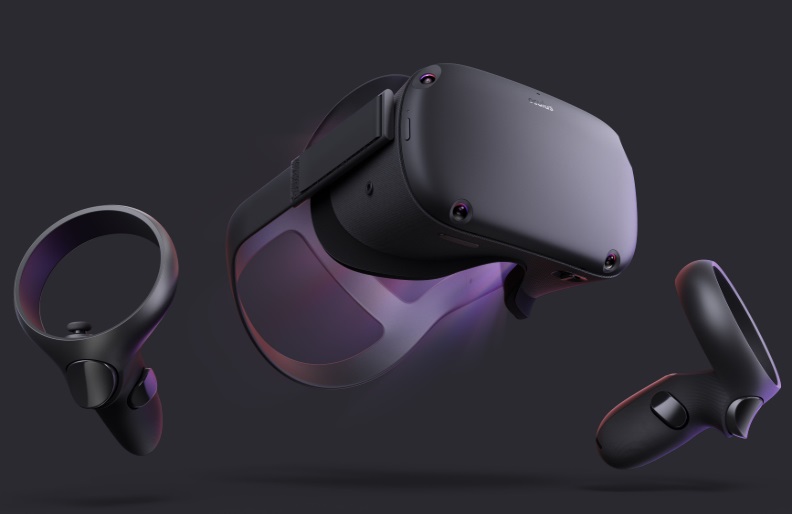What is the Oculus Quest?
Virtual reality hasn’t really kicked off yet, and I’m not surprised. The likes of the Oculus Rift and HTC Vive may both offer incredibly fun and immersive experiences, but when they take an age to set up and require an ultra-expensive computer rig to function, who can be bothered to go through the effort? Not me. But just as people were ready to label VR a flop, the Oculus Quest arrives – and it’s an absolute game-changer.
Of course, Oculus has had to make sacrifices to create this independent VR headset. The Quest isn’t capable of running GPU-intensive games at a high resolution, so you’ve little chance of exploring photo-realistic open worlds here. That said, when given the choice between a high-performance headset and the Quest’s ready-to-play convenience, I’ve no hesitation in picking the latter.
The Oculus Quest is out now, and it’s hands-down the most accessible and affordable high-quality VR headset out there. The Quest was announced last month as the most powerful self-contained VR headset at a consumer level, and it does not disappointed. It doesn’t require a gaming PC, an additional console, or external sensors; you quite literally just put it on and go. It features an intuitive grid that allows the player to set up their play area in under three minutes, which is a godsend in the VR world. And with a reasonable price, it fulfills the wishes of anyone trying to jump into the VR sphere.
One of the best features of the Quest is the completely wireless connectivity. As an all-in-one headset, you don’t need to hook the Oculus Quest to an external machine or dot sensors around the room. Charge up the headset, plonk it on your head and you’re good to go. The Oculus Go offers something similar, but thanks to a powerful Qualcomm Snapdragon 835 chip, the Quest is able to play more demanding VR games such as Superhot VR, Robo Recall and Beat Saber. All you need to worry about is the headset and the two wireless Oculus Touch controllers, allowing for untethered, 360-degree play and more real movement than we’ve seen in consumer VR up to this point. The already-ergonomic Oculus Touch controls got a slight upgrade: The sensor circle now faces up to better connect with the headset censors.
Another great feature is the visual quality. The Quest has 1,440 x 1,600 resolution and is one of the most crisp VR experiences I’ve had to date. Included on the headset is a slider that allows players to move the distance between the lenses to get the sharpest visuals available. Along with the video, the built-in speakers create a pseudo-surround-sound effect. Over all, the hardware is remarkably impressive, with very little to compromise on.
The Oculus Quest game library has over 50 hit VR titles including Beat Saber, Job Simulator, and Creed. But only the Quest is home to Vader Immortal, a new Star Wars game that puts you in a very crucial role between the events of Revenge of the Sith and A New Hope. This exclusive title is near worth the whole system itself. Without spoiling any of the story, Vader Immortal looks absolutely stunning and has a lightsaber experience good enough to live up to your childhood dreams of being a Jedi Master. Swinging, slashing, deflecting blaster bullets, parrying—all of it uses the Quest’s responsive controls to fully immerse players. The story itself is well-crafted, giving you your own Star Wars plotline.
Beyond the gaming library, you can access features like Youtube VR, Oculus TV, Netflix VR, a web browser, and more on the Quest, really making it more than a console. It also has a tool system to cast to certain TVs and phones; it’s still in beta testing, but it works pretty well already.
Oculus Quest Will Have Netflix, but Not Plex or HBO
First, the good news for anyone who has pre-ordered the headset: One of the biggest media services will be on the Quest, despite not being named among the official launch titles up until now. Representatives from Netflix and Facebook confirmed that the Netflix VR app will be available for the Quest at launch.
HBO on the other hand won’t be on the Quest, a spokesperson for the cable network confirmed. That absence isn’t a complete surprise: HBO brought both its HBO Now and its HBO Go service to VR when Google launched its Daydream VR headset in 2016. However, Daydream didn’t pan out to be much of a hit with consumers, and HBO discontinued its VR apps earlier this year.
Media center app maker Plex also didn’t build an app for the Quest, and likely won’t be doing so for some time to come. Plex chief product officer Scott Olechowski told that the company currently had no plans to port its Plex VR app to the new headset and that it was focusing its development resources on other areas instead. Plex first launched it’s VR app on Daydream in early 2018 and has since ported it to Gear VR and Oculus Go as well.
Oculus Quest will ship with Facebook’s own Oculus TV app, which functions as a launch pad for video content from providers including Facebook Watch, Fox Now, Red Bull TV and Neverthink as well as live TV from internet pay TV service Sling TV. YouTube also announced last week that it was bringing its YouTube VR app to the device, and Pluto as well as ESPN also made their apps available on launch day.
Read more: Oculus Quest and Rift S headsets are both now available starting at $399
A Facebook spokesperson said that the company would share details on additional media apps heading to the headset after the launch, adding that it was “exploring ways to make media watching even better on Oculus Quest in the future.” However, she added that the primary focus of the Quest was gaming.

3 comments